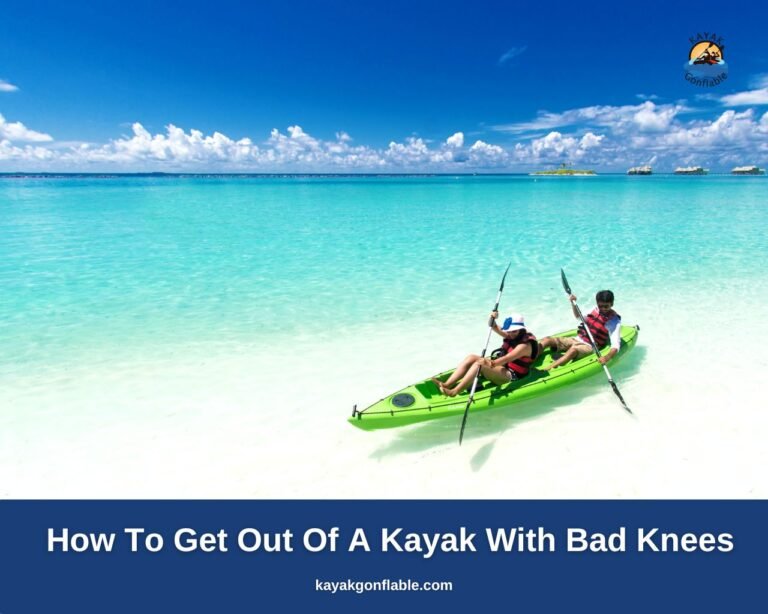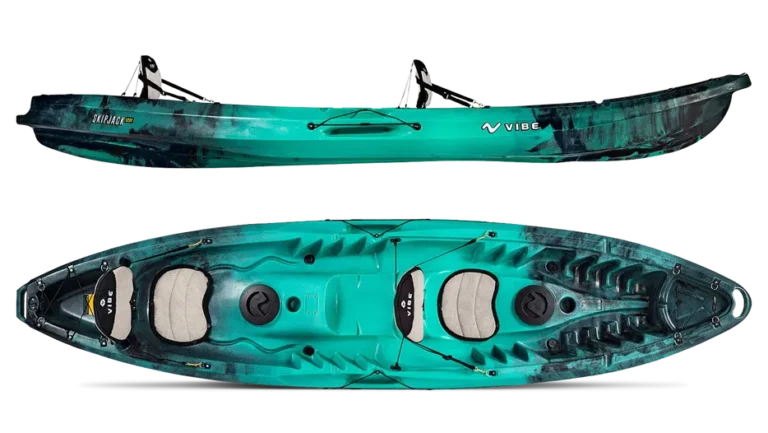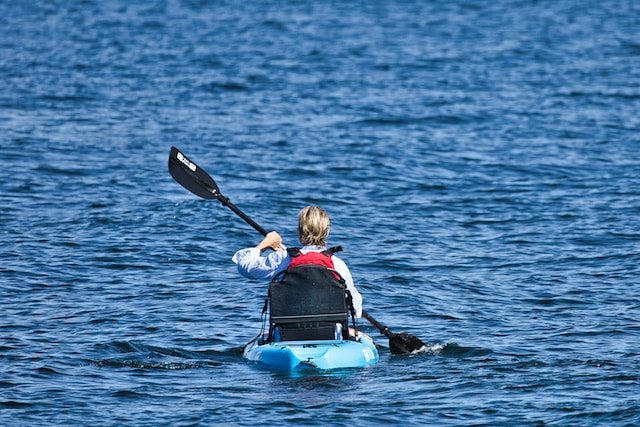What Happens When You Use Too Long Of A Paddle For Kayaking?

Kayaking is a popular and fun paddle sport enjoyed by people of all ages and fitness levels. The sport is so great that once hooked, you always want to find your way back to the water and paddle for as long as you can.
As with all things, however, kayaking has some rules that must be adhered to if the paddling adventure is to be enjoyable, and ignoring those rules always results in an unenjoyable trip and in worse cases accidents.
One of these core rules is the use of a correctly sized paddle to navigate your kayak. In this article, we look at kayak paddles, how to choose the correct size, and the consequences of using a paddle that is too long.
What Is A Kayak Paddle?
A kayak paddle is a tool used by kayakers to propel themselves through and navigate the water. Kayak paddles are generally between 2 and 3 meters in length.
They come in a variety of shapes and sizes to suit different paddling styles and are made from various materials, including wood, aluminum, carbon fiber, and fiberglass. Paddles are an essential piece of kayaking gear, and choosing the right paddle can make a big difference in your kayaking experience.
A kayak paddle has two blades, one at each end, that are connected by a shaft in the middle. The paddle is held in both hands and is used to alternate sides in a stroking motion.
In addition to providing propulsion, the paddle can be used for steering and braking. Kayak paddles with smaller shaft diameters are often for children or kayakers with small hands. The paddle blades also vary in shape and that can affect performance.
Sometimes, the color of the paddle blade has a say in safety and tells you what paddling style the paddle is best suited for
What Happens When You Use Too Long Of A Paddle For Kayaking?
As mentioned earlier, the right paddle size is necessary for a safe and enjoyable kayaking experience.
It thus comes as no surprise that when you use a paddle that is too long, your paddling experience becomes unsafe and unenjoyable, and the more the paddle exceeds the appropriate length, the more dangerous kayaking with it becomes.
The results of using a paddle that is too long are enumerated below.
- The first consequence of using a paddle that is too long for kayaking is the loss of paddling efficiency. This is because you will have to apply more energy than necessary to paddle safely resulting in you getting tired very quickly and ultimately not enjoying your kayaking adventure.
- Next is the maneuverability problem. Turning the kayak will be difficult if the paddle you are using is too long, especially if you either have to turn quickly or turn in a small space or tight corner.
- Using a paddle that is too long will put undue stress on your shoulders and wrists, which can lead to injuries over time.
- Another consequence is that using a paddle that is too long will affect the tracking ability of your kayak. The result is that keeping your kayak in a straight line while paddling becomes considerably more difficult so you will have trouble maintaining your chosen course, especially if the weather and water conditions are against you.
- The lack of stability caused by the use of a paddle that is too long puts the vessel and kayaker at risk of more problems chief of which is capsizing.
- Using a long paddle increases the risk of hitting objects in the water, which can damage the kayak or injure the paddler.
- In an effort to better control the kayak when using a paddle that is too long, your hands will be constantly moving along the paddle shaft and that could cause blisters to your palms, especially if the shaft is made of either wood or metal.
- Your paddling speed will be greatly reduced if you use a paddle that is too long. This will be a major problem particularly if you are on a schedule.
Given the consequences of using a paddle too long than is appropriate, it is very important to choose a paddle that is the right size for your height and width kayak.
Choosing The Right Kayak Paddle
There are several things a paddler should consider when choosing a paddle and they are explained below.
Paddle Length
The length of the paddle is one of the most important factors to consider when purchasing a paddle. The paddle length should be based on the kayaker’s paddling style and height.
The height of the paddler could be his overall or torso height, though the torso height is more accurate for use when choosing a kayak paddle. There are two main paddling styles.
- The low-angle paddling style: This style is an easy-going and relaxed paddling style used by most recreational and touring paddlers. The term low-angle comes from the fact that the paddle blade enters the water at a small angle in relation to the water surface. This style requires a longer paddle than the high-angle paddling style.
- The high-angle paddling style: This is a faster and more aggressive paddling style. As the name implies, in this style the paddle blade enters the water with a large angle in relation to the water surface, that is the blade is more towards the vertical while paddling. This style is mostly favored by those into racing and whitewater kayaking, sports where strength and speed are needed for a more exhilarating paddling experience. The high-angle paddling style requires a shorter paddle than its counterpart.
It is crucial to note that you should be aware of the paddling style you use to help you choose the appropriate paddle.
If you get a paddle that is inappropriate for the style you use, you will be sacrificing the paddling efficiency, stability, maneuverability, and tracking ability of your kayak resulting in both an unsafe, uncomfortable, and unenjoyable kayaking experience.
Also, note that the torso height is measured when you are sitting down from the crotch to the tip of the nose.
The tables below give you the appropriate paddle length for you based on your overall height (the first 3 tables), torso height, and paddling style. Crosscheck all tables and choose the one that most fits your variables.
Paddle Shaft Diameter
There are many things to consider when choosing a paddle, but one criterion you may not have thought of is paddle shaft diameter.
Choosing a paddle with the wrong paddle shaft diameter would make the paddle harder to use and could even give you blisters so this factor should not be taken lightly.
A smaller diameter may be better if you have small hands or if you want more control over the paddle. A larger diameter may be better if you have large hands or if you want more power.
Ultimately, it is up to you to decide what is most comfortable for you and what will work best for your paddling style.
You should also consider the materials of the paddle shaft as some materials are more durable than others, while some may be more comfortable to grip. For example, a carbon fiber shaft may be lighter and stronger than an aluminum shaft.
Blade Size
Whether you’re a beginner or a professional, the size of your paddle’s blade is an important criterion to consider when choosing a paddle.
A smaller blade will offer more control and is better suited for smaller paddlers, while a larger blade will give you more power and is better for larger paddlers. The paddle blade adds to the paddle weight so be careful when choosing the paddle.
You should also consider the length-to-width ratio of the paddle blade as that plays a role in how easy some paddling techniques like turning, bracing, and even rolling can be. The right blade size will help you paddle more efficiently and with less fatigue.
Feather Angle
Many kayakers don’t know that the feather angle of their paddle can have a big impact on their performance.
Feather angle is the degree to which the blades of the paddle are offset from each other and it typically ranges from 0 to 60 degrees. A higher angle will give you more power but less control, while a lower angle will give you more control but less power.
So, what’s the best angle for you? It depends on your paddling style and what kind of kayaking you’re doing.
The feather angle of whatever paddle you buy must fit your paddling style for a smooth and enjoyable paddling experience.
Many paddles now have adjustable ferrules that allow you to set any feather angle you desire from 0 to 90 degrees in either the left or right direction in increments of 15 degrees. This helps you adjust the paddle as you desire for optimum performance.
It is important to choose the right size paddle for your kayaking adventure. If you use a paddle that is too long, you will have to apply more power than normal to move the kayak forward, maintain stability, and keep the kayak on its course.
This can be frustrating and cause you to waste a lot of energy. The result is that you will tire yourself out more quickly and may not be able to enjoy your time on the water. A shorter paddle will give you more control and help you go faster.
Be sure to test out different paddles before you head out on your next trip to find a paddle that is the right size for you so that you can enjoy kayaking and get the most out of it.








